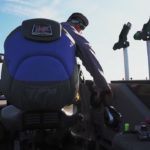Catch the Buzzzzzzzzzz Casting Crankbaits for Walleye
 With the numerous advances in angling technology and gear, trolling crankbaits for walleye has become increasingly popular. Planer boards, divers and jets, GPS, sonar and the best kicker motors ever have made trolling a favorite technique. Yet one of anglings most basic techniques, casting, can put just as many fish in the livewell.
With the numerous advances in angling technology and gear, trolling crankbaits for walleye has become increasingly popular. Planer boards, divers and jets, GPS, sonar and the best kicker motors ever have made trolling a favorite technique. Yet one of anglings most basic techniques, casting, can put just as many fish in the livewell.
Trolling definitely has its advantages. Covering large expanses of water, keeping your bait in the water for longer periods of time and targeting fish suspended in very specific depths are all great reasons to troll. But certain situations call for a crankbait sans trolling.
Casting a crankbait works well when walleye are situated in close proximity to various types of structure. For instance, if fish are positioned tight against wingdams in river systems, casting a presentation parallel to that structure is the preferred method to effectively position the bait in front of hungry fish.
Other scenarios might include walleye that currently reside close to small rock piles, isolated brush, bridge pilings, and clumps of weeds. And of course, the most common place to utilize the effectiveness of a cast for walleye fishing is from shore.
Repeat
Repeatedly casting a crankbait alongside structure is the key to catching structurally dependent walleye. Even though fish may not respond to your first, second, or even third cast in the same area the repetitive presence of your bait encourages walleye to react. There are certainly times when active fish will slam your crankbait within the first three turns of the reel handle, but maximizing catches means dedicating that crankbait to working the water into a froth. If at first you don’t succeed, cast, cast again.
 Getting Stung
Getting Stung
Crankbaits vary by color and design, but one that has been consistently effective for catching walleye is the Salmo Hornet. Making the choice between the floating and the sinking models simply depends upon the depth you’re casting to and where the fish are positioned within the water column. Casting the Salmo Hornet is no different than any other crankbait, but the size of Hornet you choose dictates what rod and reel you will employ. The #6 Hornet is the largest in the family and will cast farther due to the heavier weight. A baitcasting outfit is best for tossing the #6 Hornet around, while a spinning rod makes more sense for the smaller #5, #4, and #3 size baits. Line weight definitely makes a difference in the running depth and action of the Hornet, or any crankbait that exists. Larger line weights prohibit the action of a crankbait, so choose monofilament, fluorocarbon or braid with small diameters to maximize the performance of the lure.
Repellants
Some anglers become quickly discouraged while casting a crankbait for a few reasons. During the retrieve your rod tip will vibrate because of the action from the lure. The vibration is what draws the fish toward your bait, both visually and auditorily. That shaking ceases every time vegetation hangs up on the lip or hooks of the bait. When fishing flowing water where dead vegetation floats in the current and weedy areas with variated height, catching weeds can be annoying. Keeping the frame of mind that this will happen and it’s simply a part of fishing may put the positive spin on pulling weed after weed from your hooks.
Casting crankbaits can also present a safety issue when there are more than a couple of people in the boat. Four children and two adults in a boat launching lures with multiple hooks will add more to your hospital bill and less to the frying pan. Creating a safe angling environment is imperative to casting crankbaits, a super technique for catching walleye!





